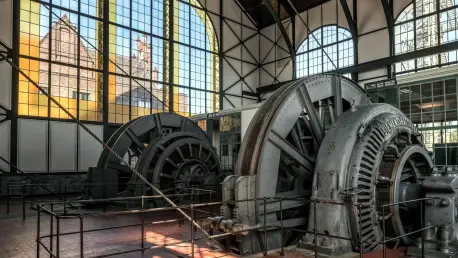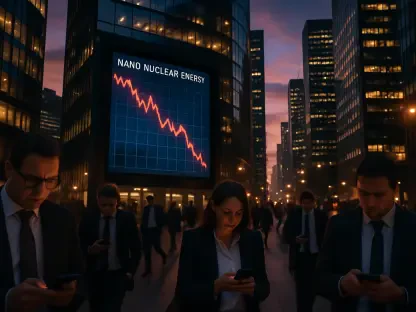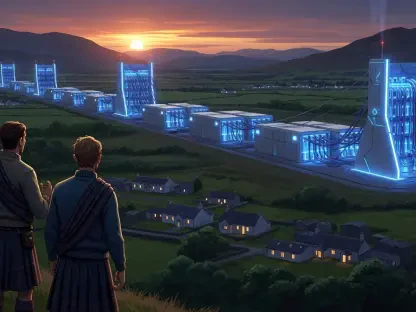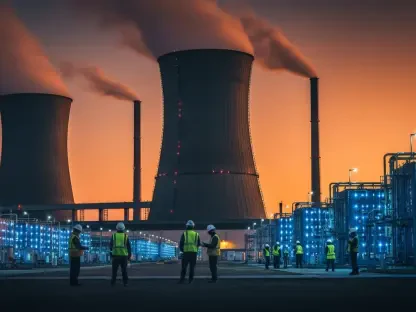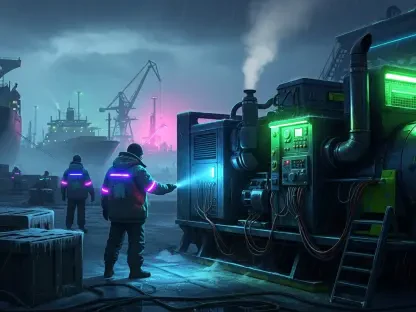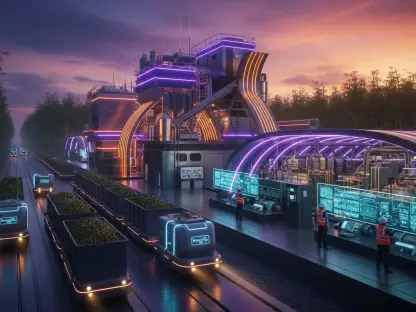In the heart of downtown Denver, at 730 17th Street, stands a 133-year-old architectural treasure that’s undergoing a transformative renovation to align with the city’s strict energy-efficiency standards while preserving its deep-rooted historical essence. Constructed in 1892 and listed on the National Register of Historic Places, this nine-story structure, once dubbed part of the “Wall Street of the West,” embodies Italian Renaissance Revival style with intricate details like marble pillars and a Tiffany stained glass window. Today, a $5.5 million project led by Elevate Real Estate Services Inc. is redefining its future, tackling the dual challenge of sustainability and heritage with innovative solutions. This ambitious endeavor not only aims to cut energy costs by an estimated 40% but also sets a precedent for how historic buildings can adapt to modern environmental demands without losing their timeless charm.
The renovation comes at a critical juncture as Denver pushes forward with aggressive sustainability goals through its Office of Climate Action, Sustainability, and Resiliency. A major component of the project focuses on replacing an outdated steam-heat system, tied to a century-old downtown steam loop, with a more efficient natural gas alternative. This shift addresses both regulatory mandates and economic pressures, as heating costs alone have ballooned to $200,000 annually. Beyond the numbers, the effort reflects a delicate balance of maintaining the building’s iconic features while integrating cutting-edge technology, making it a compelling case study in urban redevelopment. As cities nationwide grapple with similar challenges, this historic edifice offers a glimpse into the possibilities of merging past and future seamlessly.
Revamping for a Sustainable Tomorrow
Addressing Regulatory and Financial Imperatives
Denver’s strict energy reduction targets, driven by the Office of Climate Action, Sustainability, and Resiliency, have placed significant pressure on large structures to minimize their environmental footprint. For the historic building at 730 17th Street, this mandate intersects with a pressing financial reality: the outdated steam-heat system, reliant on the downtown steam loop, has become a costly burden. With annual heating expenses reaching $200,000—over half of the total utility costs—continuing with the old system was no longer viable. The decision to transition to a natural gas system, expected to slash energy costs by around 40%, aligns with the city’s goals while offering substantial savings for the office owners who manage the property under a commercial homeowners association model. This move underscores the dual motivation of compliance and economic necessity shaping the renovation’s direction.
Beyond the immediate financial relief, the shift away from the steam loop mirrors a broader movement across Denver, where many buildings face similar challenges with escalating rates that have doubled over the past decade. The city’s push for lower energy use per square foot is not just a guideline but a critical step toward a greener urban landscape. For this historic structure, achieving an energy efficiency rating of 57.1, surpassing the city’s 2028 target, demonstrates how targeted upgrades can yield measurable outcomes. The natural gas conversion, while not a fully carbon-neutral solution, serves as a practical interim step, especially when alternatives like full electrification posed prohibitive costs and logistical hurdles. This strategic choice highlights the complexities of retrofitting aging infrastructure under modern regulatory frameworks, balancing short-term gains with long-term sustainability aspirations.
Tackling the High Costs of Inefficiency
The financial strain of maintaining the century-old steam loop system has been a defining factor in the renovation strategy for this downtown landmark. With heating costs consuming a staggering $200,000 each year, and steam rates doubling over recent years, the economic rationale for change became undeniable. This inefficiency not only impacted the bottom line for the building’s office owners but also underscored the broader unsustainability of relying on outdated infrastructure in an era of rising energy expenses. The switch to a natural gas system emerged as a clear solution, promising significant cost reductions while aligning with the city’s energy mandates. This transition is more than a fiscal adjustment; it’s a critical pivot toward operational resilience in a competitive urban real estate market.
Moreover, the economic challenges tied to the steam loop are not unique to this building but reflect a citywide issue affecting numerous downtown properties. As rates continue to climb, the urgency to adopt more efficient heating alternatives grows, pushing property managers to rethink traditional systems. For this historic site, the projected 40% reduction in energy costs through natural gas offers a lifeline, ensuring the building remains financially viable for its stakeholders. This economic transformation also sets an example for other structures grappling with similar inefficiencies, proving that modern solutions can address longstanding fiscal burdens. The focus on cost savings, while driven by necessity, complements the broader goal of environmental responsibility, illustrating how economic and ecological priorities can converge in urban renewal projects.
Honoring History While Embracing Change
Safeguarding a Cultural Landmark
Preservation of historical integrity stands as a cornerstone of the renovation at 730 17th Street, where every modern upgrade must respect the building’s storied past. Known for its Italian Renaissance Revival architecture, the structure boasts ornate elements like mosaic-tiled vaulted ceilings, a bronze staircase, and a granite facade adorned with terra cotta ornamentation. These features, protected by an easement with Historic Denver, required meticulous planning to ensure that sustainability efforts did not compromise aesthetic or cultural value. A key decision—placing a massive 22,000-pound boiler plant on the roof rather than at street level—was made to maintain the building’s iconic exterior appearance. This careful approach reflects a deep commitment to honoring a legacy that dates back to 1892, balancing it with the demands of the present.
The involvement of Historic Denver in the approval process underscores the importance of collaboration in projects of this nature. Every modification, from the rooftop installation to internal system upgrades, was scrutinized to avoid detracting from the building’s historical character, including treasures like a Tiffany stained glass window. This rigorous oversight ensured that the renovation respected the cultural significance of a site once central to Denver’s financial district. The effort to preserve such details while integrating modern systems highlights a growing recognition that historic buildings are not just relics but living assets in urban environments. By prioritizing visual and structural integrity, the project demonstrates how heritage conservation can coexist with the push for energy efficiency, offering a blueprint for other cities facing similar dilemmas.
Navigating the Constraints of Legacy Design
Retrofitting a 133-year-old structure presents unique challenges, particularly when its design was never intended to accommodate modern energy systems. The building’s layout and protected status limited options for where new equipment could be installed, necessitating creative solutions to avoid visible alterations. The decision to hoist a heavy boiler plant onto the roof, for instance, was driven by spatial constraints and city code requirements, ensuring no disruption to the street-level facade. This placement, while logistically complex, was essential to uphold the architectural harmony that defines the building’s historical significance. Such constraints highlight the intricate balance between innovation and preservation in updating landmarks for contemporary use.
Additionally, the inherent design features of the structure, such as its thick granite foundation, offered unexpected advantages in the renovation process. This natural insulation contributed to the building’s impressive Energy Star score of 83 out of 100, complementing the new heating system’s efficiency. However, adapting other elements to meet current standards required balancing historical authenticity with functional needs. The oversight from preservation advocates ensured that even minor changes aligned with the building’s original aesthetic. This meticulous process, while time-intensive, reinforces the value of patience and precision in projects where history and modernity intersect. The outcome serves as a testament to how constraints can inspire innovative thinking, ensuring that legacy structures remain relevant without sacrificing their past.
Pioneering Solutions and Urban Trends
Leveraging Technology for Seamless Upgrades
Innovation in engineering has played a pivotal role in transforming the historic building at 730 17th Street into a model of energy efficiency. In partnership with Braconier, a Colorado-based mechanical firm with extensive expertise, Elevate Real Estate Services Inc. utilized LiDAR technology to create precise 3-D models of the structure. This cutting-edge approach enabled the prefabrication of a 22,000-pound boiler plant, which was then hoisted onto a specially designed rooftop platform. Described as akin to assembling a Lego set, this method minimized onsite disruption and addressed the spatial limitations of a century-old design. The seamless integration of modern technology into a historic framework showcases how advanced tools can solve unique challenges in retrofitting projects.
The use of such sophisticated techniques also reflects a commitment to efficiency in both time and resources during the renovation. By assembling critical components offsite based on detailed digital scans, the project avoided prolonged construction that could have impacted daily operations within the building. This precision ensured that the installation aligned perfectly with city codes and preservation requirements, maintaining the structure’s aesthetic integrity. Furthermore, the successful execution of this complex task highlights the potential for technology to bridge the gap between old and new in urban redevelopment. As other historic buildings face similar modernization needs, this approach offers a replicable strategy for minimizing disruption while achieving ambitious energy goals, setting a new standard for adaptive reuse in constrained environments.
Aligning with Citywide Environmental Visions
The renovation at 730 17th Street is not an isolated effort but part of a larger movement toward sustainability in Denver, where the city is actively exploring innovative heating and cooling solutions. Supported by a $4.9 million grant for a pilot program, local authorities are investigating shared, carbon-free systems to replace outdated infrastructure like the downtown steam loop. While the shift to natural gas at this historic site represents a practical interim measure, it acknowledges the limitations of alternatives like heat pumps or full electrification, which posed significant cost and logistical barriers. This pragmatic step aligns with the city’s broader vision, even as it falls short of a fully green solution, illustrating the incremental nature of progress in urban sustainability efforts.
This project also serves as a microcosm of the challenges and opportunities facing cities nationwide as they strive to update aging infrastructure without erasing historical value. Denver’s commitment to reducing energy consumption per square foot in large buildings is a forward-thinking policy that pushes property managers to rethink traditional systems. For the building in question, surpassing the 2028 energy efficiency target with a rating of 57.1—well ahead of the 2032 goal of 48.3—demonstrates the impact of strategic upgrades. The city’s ongoing feasibility studies for carbon-neutral alternatives suggest that future innovations may build on interim solutions like natural gas. This evolving landscape of urban environmental policy positions Denver as a leader in balancing growth with ecological responsibility, with this historic renovation providing valuable insights for similar initiatives elsewhere.
Reflecting on a Model of Adaptation
Looking back, the $5.5 million renovation of the downtown Denver landmark at 730 17th Street captured the essence of harmonizing historical reverence with modern imperatives. The transition from a costly steam-heat system to natural gas, coupled with a rooftop boiler installation using state-of-the-art engineering, marked a significant stride toward sustainability. Achieving a 40% reduction in energy costs, surpassing city efficiency targets, and earning a high Energy Star score reflected the project’s success in measurable terms. Modernized elevators, enhanced fire safety systems, and a restored facade further ensured the building’s longevity. For urban planners and property managers, the takeaway was clear: thoughtful collaboration and innovative design could transform historic structures into sustainable assets. Moving forward, leveraging emerging carbon-free technologies and fostering partnerships between stakeholders will be crucial to sustaining this balance of heritage and progress in cities everywhere.
